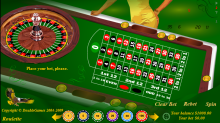Betting strategies and tactics
Albert Einstein is reputed to have stated, “You cannot beat a roulette table unless you steal money from it”. Indeed as with all common casino games with each bet placed the player’s chances of winning decrease exponentially.
Over the years, many people have tried to beat the casino, and turn roulette – a game designed to turn a profit for the house – into one on which the player expects to win. Most of the time this comes down to the use of betting systems, strategies which say that the house edge can be beaten by simply employing a special pattern of bets, often relying on the “Gambler’s fallacy”, the idea that past results are any guide to the future (for example, if a roulette wheel has come up 10 times in a row on red, that red on the next spin is any more or less likely than if the last spin was black).
All betting systems when employed on casino edge games will result, on average, in the player losing money. In practice, players employing betting systems may win, and may indeed win very large sums of money, but the losses (which, depending on the design of the betting system, may occur quite rarely) will outweigh the wins. Certain systems, such as the Martingale, described below, are extremely risky, because the worst case scenario (which is mathematically certain to happen, at some point) may see the player chasing losses with ever bigger bets until he runs out of money.
At least in the 1930s, some professional gamblers were able to consistently gain an edge in roulette by seeking out rigged wheels (not difficult to find at that time) and betting opposite the largest bets.
Biased wheels
Whereas betting systems are essentially an attempt to beat the fact that a geometric series with initial value of 0.95 (American roulette) or 0.97 (European roulette) will inevitably over time tend to zero, engineers instead attempt to overcome the house edge through predicting the mechanical performance of the wheel, most notably by Joseph Jagger at Monte Carlo in 1873. These schemes work by determining that the ball is more likely to fall at certain numbers, and if sufficiently good will raise the return of the game above 100%, defeating the betting system problem.
In the early 1990s, Gonzalo Garcia-Pelayo believed that casino roulette wheels were not perfectly random, and that by recording the results and analysing them with a computer, he could gain an edge on the house by predicting that certain numbers were more likely to occur next than the 1-in-36 odds offered by the house suggested. This he did at the Casino de Madrid in Madrid, Spain, winning 600,000 euros in a single day, and one million euros in total. Legal action against him by the casino was unsuccessful, it being ruled that the casino should fix its wheel.
To prevent exploits like these, the casinos monitor the performance of their wheels, and rebalance and realign them regularly to try to keep the result of the spins as uniform as possible.
In 1982, several casinos in Britain began to lose large sums of money at their roulette tables to teams of gamblers from the USA. Upon investigation by the police, it was discovered they were using a legal system of biased wheel-section betting. As a result of this, the British roulette wheel manufacturer John Huxley manufactured a roulette wheel to counteract the problem.
The new wheel, designed by George Melas, was called “low profile” because the pockets had been drastically reduced in depth, and various other design modifications caused the ball to descend in a gradual approach to the pocket area. In 1986, when a professional gambling team headed by Billy Walters won $3.8 million using the system on an old wheel at the Golden Nugget in Atlantic City, every casino in the world took notice, and within one year had switched to the new low-profile wheel.
Edward O. Thorp (the developer of card counting and an early hedge-fund pioneer) and Claude Shannon (a mathematician and electronic engineer best known for his contributions to information theory) built arguably the first wearable computer to predict the landing of the ball in 1961. This system worked by timing the ball and wheel, and using the information obtained to calculate the most likely octant where the ball would fall. Ironically, this technique works best with an unbiased wheel though it could still be countered quite easily by simply closing the table for betting before beginning the spin.
Thomas Bass, in his book The Eudaemonic Pie 1991 (published as The Newtonian Casino in Britain), has claimed to be able to predict wheel performance in real time. The book describes the exploits of a group of University of California Santa Cruz students, who called themselves the Eudaemons, who in the late 1970s used computers in their shoes to win at roulette. This is an updated and improved version of Edward O Thorp’s approach where Newtonian Laws of Motion are applied to track the roulette ball’s deceleration, hence the title.
In 2004 it was reported that a group of two Serbs and one Hungarian in London had used a laser scanner hidden inside a mobile phone linked to a computer to predict the sector of the wheel where the ball was most likely to drop. They were arrested, but released without charge as there was no proof they had technically interfered with casino equipment.
Specific betting systems
The numerous even-money bets in roulette have inspired many players over the years to attempt to beat the game by using one or more variations of a Martingale betting strategy, wherein the gamer doubles the bet after every loss, so that the first win would recover all previous losses, plus win a profit equal to the original bet. The problem with this strategy is that, remembering that past results do not affect the future, it is possible for the player to lose so many times in a row, that the player, doubling and redoubling his bets, either runs out of money or hits the table limit. A large financial loss is certain in the long term if the player continued to employ this strategy. Another strategy is the Fibonacci system, where bets are calculated according to the Fibonacci sequence. Regardless of the specific progression, no such strategy can statistically overcome the casino’s advantage, since the expected value of each allowed bet is negative.
While not a strategy to win money, former Los Angeles Times editor Andrés Martinez described a betting method in his book on Las Vegas titled “24/7”. He called it the “dopey experiment”. The idea is to divide one’s roulette session bankroll into 35 units. This unit is bet on a particular number for 35 consecutive spins. Thus, if the number hits in that time, the gambler wins back the original bankroll and can play subsequent spins with house money. However, there is only a 1 − (37 / 38)35 = 60.68% probability of winning within 35 spins (assuming a double-zero wheel with 38 pockets).
There is a common misconception that the green numbers are “house numbers” and that by betting on them, one “gains the house edge.”[citation needed] In fact, it is true that the house’s advantage comes from the existence of the green numbers (a game without them would be statistically fair); however, they are no more or less likely to come up than any other number.
At some point in time, playing a specific system may be profitable for some players. This however, does not guarantee that the wins are the result of the system itself and not due to luck. In these cases, further evaluation of the system is required before concluding that it is a “winning system”.
Labouchere System
The Labouchere System is a progression betting strategy like the Martingale but does not require the gambler to risk his stake as quickly with dramatic double-ups. The Labouchere System involves using a series of numbers in a line to determine the bet amount, following a win or a loss. Typically, the player adds the numbers at the front and end of the line to determine the size of the next bet. When he wins, he crosses out numbers and continues working on the smaller line. If he loses, then he adds his previous bet to the end of the line and continues to work on the longer line. This is a much more flexible progression betting system and there is much room for the player to design his initial line to his own playing preference.
This system is one that is designed so that when the player has won over a third of his bets (less than the expected 18/38), he will win. Whereas the Martingale will cause ruin in the event of a long sequence of successive losses, the Labouchere system will cause bet size to grow quickly even where a losing sequence is broken by wins. This occurs because as the player loses, the average bet size in the line increases.
As with all other betting systems, the average value of this system is negative.
D’Alembert System
The system, also called montant et demontant (from French, meaning upwards and downwards), is often called a pyramid system. It is based on a mathematical equilibrium theory devised by a French mathematician of the same name. Like the Martingale, this system is mainly applied to the even-money outside bets, and is favored by players who want to keep the amount of their bets and losses to a minimum. The betting progression is very simple: After each loss, one unit is added to the next bet, and after each win, one unit is deducted from the next bet. Starting with an initial bet of, say, 10 units, a loss would raise the next bet to 11 units. If this is followed by a win, the next bet would be 10 units. Another win would lower the next bet to 9 units.
This betting system relies on the gambler’s fallacy – that the player is more likely to lose following a win, and more likely win following a loss.
Other systems
There are numerous other betting systems that rely on this fallacy, or that attempt to follow ‘streaks’ (looking for patterns in randomness), varying bet size accordingly.
Many betting systems are sold online, and may make outlandish promises that the player can ‘beat’ the system by following them. One such system was advertised by Jason Gillon of Rotherham, UK, who claimed you could ‘earn £200 daily’ by following his betting system, described as a ‘loophole’. As the system was advertised in the UK press, it was subject to Advertising Standards Authority regulation, and following a complaint, it was ruled by the ASA that Mr. Gillon had failed to support his claims you could earn £200 daily, and that he had failed to show that there was any loophole.
Using the dozen bet
There are two versions to this system, single-dozen bets and double-dozen bets. In the single-dozen-bet version, the player uses a progressively incrementing stake list starting from the casino table minimum, to the table maximum. The aim here is to use a single-dozen bet to win before the stake list ends. Many techniques are employed such as: betting on the same dozen to appear after two consecutive appearances, betting on the dozen that has appeared most in the last 15, 9, or 5 spins, betting on the dozen that, after a long absence of 7 or more spins, appears for the first time. The double-dozen bet version uses two dozen bets and half the stake list size of the single-dozen-bet version.



